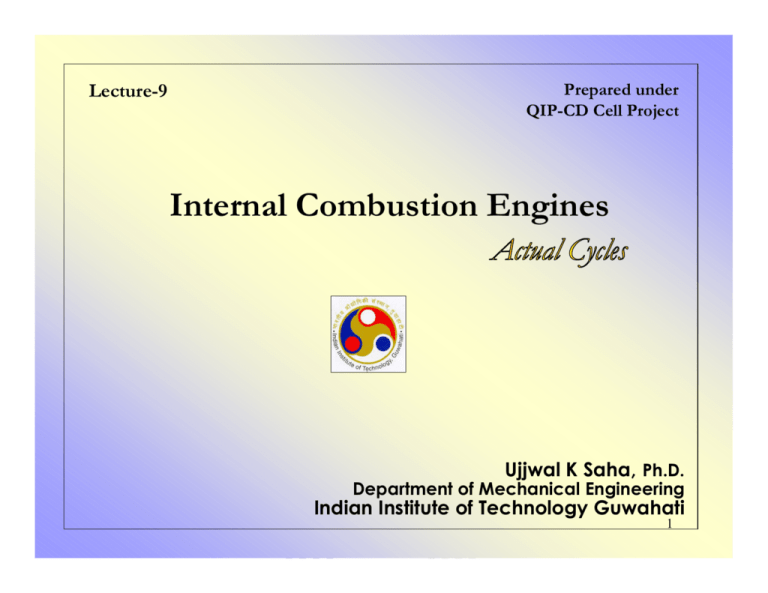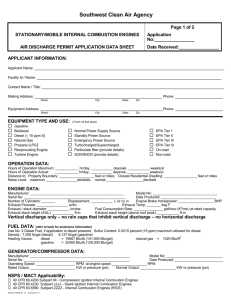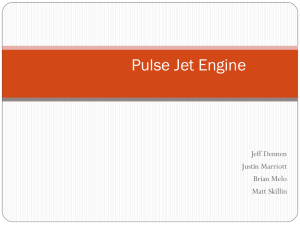Actual Cycles - IIT Guwahati
advertisement

Lecture-9 Prepared under QIP-CD Cell Project Internal Combustion Engines Ujjwal K Saha, Ph.D. Department of Mechanical Engineering Indian Institute of Technology Guwahati 1 Actual Cycles Corrected for characteristics of fuel-air mixture Air Standard Cycles Corrected for Losses Fuel-Air Cycles Actual Cycles 2 Losses – in Actual cycles Time Loss Heat Loss Blow-down Loss Blowby Loss Rubbing Friction Loss Pumping Loss 3 Time Loss It is due to the time required for mixing of air-fuel mixture and complete combustion. Heat addition is not instantaneous, and spread over a period (30 to 40 degrees of crankshaft revolution). Therefore, pmax is not at TDC, but just after TDC. Time loss depends upon flame velocity which, in turn, again depends on type of fuel used, A/F ratio, and shape of combustion chamber. 4 This is to have pmax at TDC. If the spark is initiated at TDC, peak pressure would be low due to expansion of gases. Further, if the spark is initiated too early, additional work is required to compress the burning gases – which is a direct loss. Therefore, the optimum time to start the combustion is 150 – 300 bTDC. Spark Advance Spark at TDC, Advance 00 5 Spark Advance of 350 Optimum Spark Advance Remark: Best compromise is to go for moderate spark advance so as to have smaller losses in both compression and expansion strokes. 6 Cycle Performance at Various Ignition Timing 7 Heat Loss This is due to the transfer of heat through water jackets and cooling fins. Also, some heat is being transferred during compression and expansion processes. Due to heat loss, temperature (Tmax) decreases, and specific heat gets reduced. This decreases the efficiency. 8 Blow-down Loss Blowdown loss is due to the early opening of exhaust valves. This results in drop in pressure, and a loss of work output during expansion stroke. Too early opening results in loss of expansion work. Best compromise is between 400 – 600 bBDC. 9 The effects of exhaust valve early opening greatly exaggerated 10 Time Loss, Heat Loss and Exhaust Loss 11 Blowby Losses The blowby loss is due to the leaking of gas flow through crevices/gaps between the piston, piston rings and cylinder walls. The gas usually leaks/flows through them to the crankcase. 12 Compression Rings 13 Rubbing Friction Losses Rubbing friction loss is due to friction between the piston and chamber walls, friction in various bearings and also includes the energy spent in operating various auxiliary equipments such as cooling fans, water pumps etc. The piston ring friction increases rapidly with engine speed. It also increases to a small extent with increase in mean effective pressure. The bearing friction and the auxiliary friction also increase with engine speed. 14 The efficiency of an engine is maximum at full load and decreases at part load. This is because the % of direct heat loss, pumping loss and rubbing friction loss increase at part loads. The approximate losses for an SI engine using chemically correct mixture are shown as % of fuel energy input. 15 Remark Increasing the load (load may be defined as the ratio of power developed to normal rated power at same speed) increases the maximum pressure in the cylinder which results in slight increase in friction values. At the same time, increase in load results in increase in temperature inside the cylinder and also the temperature of lubricating oil. The decrease in the oil viscosity (due to higher temperature) reduces the friction slightly. 16 17 Pumping Losses Pumping work is the difference between the work done in expelling the gases (during exhaust stroke) and the work done in inducing the fresh charge (during suction stroke). The loss is due to the pumping gases from low inlet pressure to high exhaust pressure. 18 Summary 1. Real engines operate on an open cycle with changing composition. Not only does the inlet gas composition differ from what exists, but often the mass flow rate is not the same. 2. Engines which add fuel into the cylinders after the air induction is complete (CI engines and some SI engines) change the amount of mass in the gas composition. Thus, there is a greater mass exiting the engine than what entered. 19 Summary 3. During combustion, total mass remains about the same but the molar quantity changes. Finally, there is a loss of mass during the cycle due to crevice flow and blowby past the pistons. This blowby can decrease the amount of mass in the cylinders as much as 1 % during compression and combustion. 20 Summary 4. Air-standard analysis treats the fluid through the entire engine as air, and approximates air as an ideal gas. A more serious error is introduced by assuming constant specific heats for the analysis. Specific heats of a gas have a fairly strong dependency on temperature and can vary as much as 30 % in the temperature range of the engine. 5. There are heat losses during the cycle of a real engine. Heat loss during combustion lowers actual peak temperature and pressure from what is predicted. The actual power stroke, therefore, starts at a lower pressure, and the work output during expansion is decreased. 21 Summary 6. Combustion requires a short but finite time to occur, and heat addition is not instantaneous at TDC. By starting combustion bTDC, cylinder pressure increases late in the compression stroke, requiring greater negative work in that stroke. Further, as combustion continues slightly aTDC, some power is lost at the beginning of expansion stroke. 7. Another loss in the combustion process of an actual engine occurs because of combustion efficiency, which is less than 100 %. This happens due to imperfect mixing, local variations in temperature and air-fuel due to turbulence, flame quenching etc. SI engines usually have a combustion efficiency of about 95 %, while CI engines are generally 98 % efficient. 22 Summary 8. Blow-down process requires a finite time to occur and does not occur at constant volume as assumed in the air-standard cycle analysis. For this reason exhaust valve open 400 to 600 bBDC, and work output at the latter end of the expansion is lost. 9. Engine valves require a finite time actuate. Ideally, valves would open and close instantaneously, but this is not possible when using a camshaft. Cam profiles must allow for smooth interaction with the cam follower, and this results in fast but finite valve actuation. To ensure that inlet valve is fully open at the beginning of suction stroke, it must start to open bTDC. Similarly, the exhaust valve must remain fully open until the end of exhaust stroke, with final closure occurring aTDC. 23 Valve Mechanisms rocker valve push rod piston valve lifter camshaft Timing marks cam crankshaft 24 Summary 10. Because of these differences, results obtained from the air-standard analysis will have errors and will deviate from actual conditions. Interestingly, however, these errors are not great, and property values of temperature and pressure are very representative of actual engine values, depending on the geometry and operating conditions of the real engine. 11. By changing operating variables such as inlet temperature, and/or pressure, compression ratio, peak temperature etc. in air-standard analysis, good approximations can be obtained for output changes that will occur in real engine. 25 Summary 12. Indicated thermal efficiency of a real four stroke SI engine is always somewhat less than the what airstandard Otto cycle analysis predicts. This is caused by the heat losses, friction, ignition timing, finite time of combustion and blow-down, and deviation from ideal gas behavior of the real engine. 13. It has been found that over a large range of operating variables, the indicated thermal efficiency of an actual SI four-stroke cycle engine can be approximated by: (ηt)actual ≈ 0.85 (ηt)Otto This will be correct to within a few % for large ranges of air-fuel equivalence ratio, ignition timing, engine speed, compression ratio, inlet pressure, exhaust pressure and valve timing. 26 References Crouse WH, and Anglin DL, DL (1985), Automotive Engines, Tata McGraw Hill. 2. Eastop TD, and McConkey A, (1993), Applied Thermodynamics for Engg. Technologists, Addison Wisley. 3. Fergusan CR, and Kirkpatrick AT, (2001), Internal Combustion Engines, John Wiley & Sons. 4. Ganesan V, (2003), Internal Combustion Engines, Tata McGraw Hill. 5. Gill PW, Smith JH, and Ziurys EJ, (1959), Fundamentals of I. C. Engines, Oxford and IBH Pub Ltd. 6. Heisler H, (1999), Vehicle and Engine Technology, Arnold Publishers. 7. Heywood JB, (1989), Internal Combustion Engine Fundamentals, McGraw Hill. 8. Heywood JB, and Sher E, (1999), The Two-Stroke Cycle Engine, Taylor & Francis. 9. Joel R, (1996), Basic Engineering Thermodynamics, Addison-Wesley. 10. Mathur ML, and Sharma RP, (1994), A Course in Internal Combustion Engines, Dhanpat Rai & Sons, New Delhi. 11. Pulkrabek WW, (1997), Engineering Fundamentals of the I. C. Engine, Prentice Hall. 12. Rogers GFC, and Mayhew YR, YR (1992), Engineering Thermodynamics, Addison 1. Wisley. 13. Srinivasan S, (2001), Automotive Engines, Tata McGraw Hill. 14. Stone R, (1992), Internal Combustion Engines, The Macmillan Press Limited, London. 15. Taylor CF, (1985), The Internal-Combustion Engine in Theory and Practice, Vol.1 & 2, The MIT Press, Cambridge, Massachusetts. 27 Web Resources 1. 2. 3. 4. 5. 6. 7. 8. 9. 10. 11. 12. 13. 14. 15. 16. 17. 18. 19. 20. 21. 22. 23. http://www.mne.psu.edu/simpson/courses http://me.queensu.ca/courses http://www.eng.fsu.edu http://www.personal.utulsa.edu http://www.glenroseffa.org/ http://www.howstuffworks.com http://www.me.psu.edu http://www.uic.edu/classes/me/ me429/lecture-air-cyc-web%5B1%5D.ppt http://www.osti.gov/fcvt/HETE2004/Stable.pdf http://www.rmi.org/sitepages/pid457.php http://www.tpub.com/content/engine/14081/css http://webpages.csus.edu http://www.nebo.edu/misc/learning_resources/ ppt/6-12 http://netlogo.modelingcomplexity.org/Small_engines.ppt http://www.ku.edu/~kunrotc/academics/180/Lesson%2008%20Diesel.ppt http://navsci.berkeley.edu/NS10/PPT/ http://www.career-center.org/ secondary/powerpoint/sge-parts.ppt http://mcdetflw.tecom.usmc.mil http://ferl.becta.org.uk/display.cfm http://www.eng.fsu.edu/ME_senior_design/2002/folder14/ccd/Combustion http://www.me.udel.edu http://online.physics.uiuc.edu/courses/phys140 http://widget.ecn.purdue.edu/~yanchen/ME200/ME200-8.ppt 28





